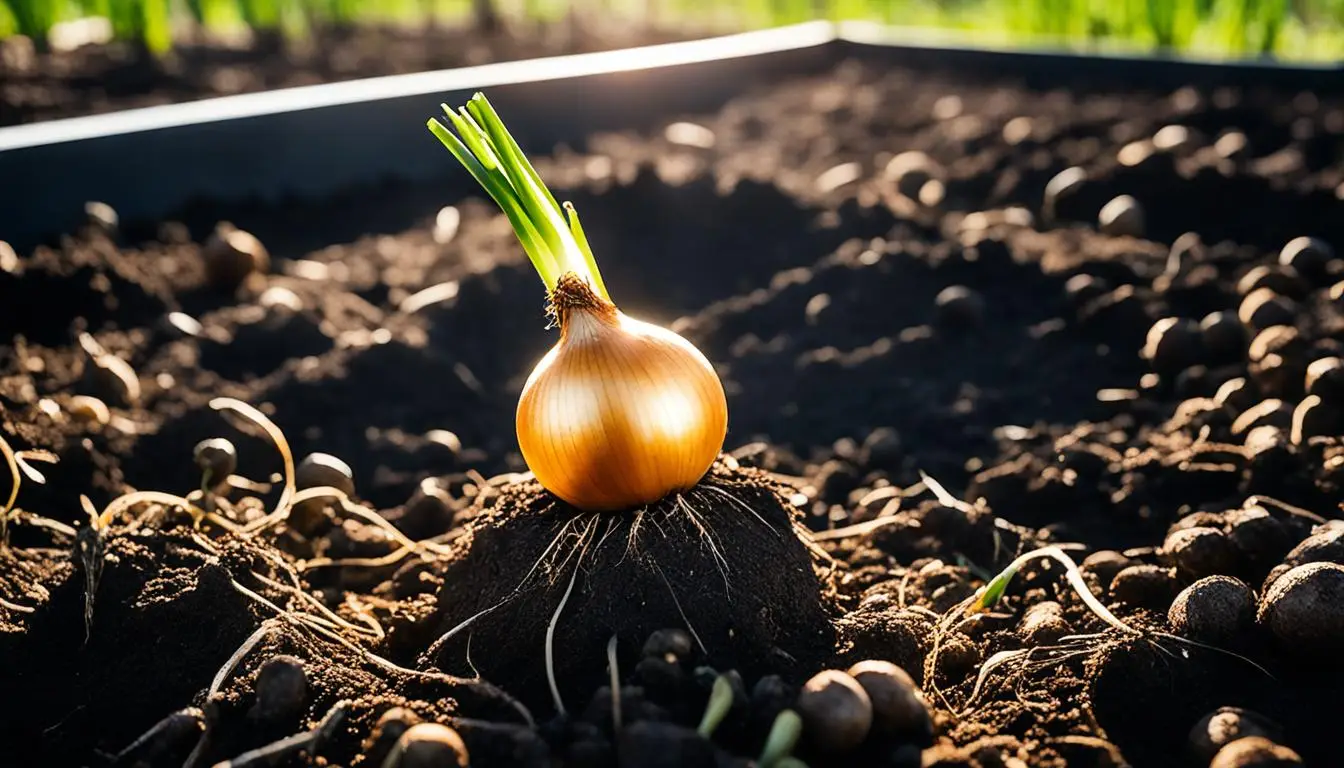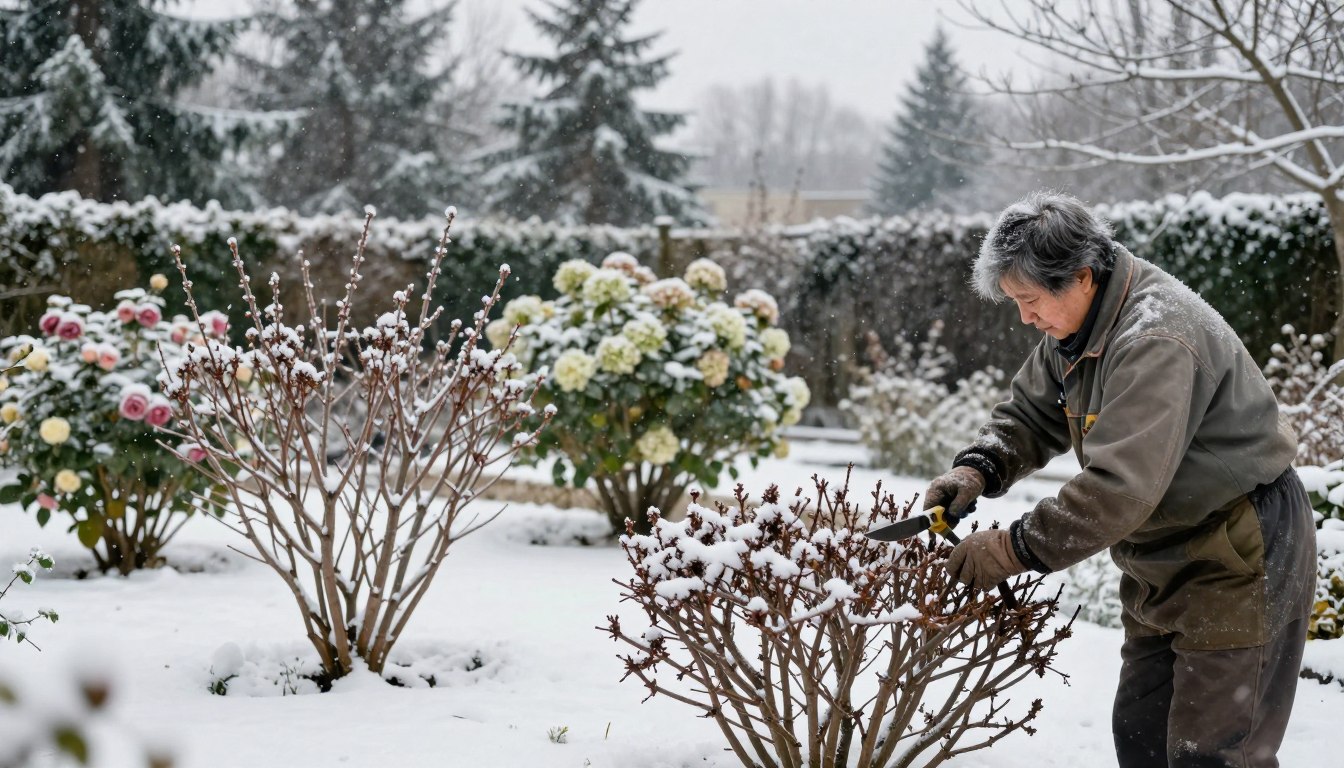Picture a garden filled with the scent of freshly picked onions. Could anything be more important to grow? Onions are key for any garden. With the right steps, you can have lots of onions for a long time. This makes your harvest great.
This guide dives into the world of growing onions. We’ll talk about picking the best kind and how to harvest them well. If you’re a new gardener or an old hand, you’ll learn something here. You’ll get tips to grow lots of onions. Plus, they’ll make your meals better and tastier.
Key Takeaways
- Onions are a versatile and essential vegetable that can be grown in small spaces and stored for months.
- Understanding the different types of onions (long-day, short-day, and day-neutral) is crucial for selecting the right variety for your growing conditions.
- Proper soil preparation, planting techniques, and ongoing care are essential for a bountiful onion harvest.
- Timing the harvest and curing process correctly is key to ensuring long-term storage and maximum flavor.
- Companion planting with onions can help deter pests and promote the health of other vegetables in your garden.
Introduction to Growing Onions
Onions are key in the garden and in the kitchen. They come in many varieties, each with its own taste. Allium cepa is their scientific name. They don’t need a lot of room to grow and you can keep them for months. This makes them perfect for those who grow their own food. I will talk about how important they are and look at the different onion types. These are long-day, short-day, and day-neutral onions.
Importance of Onions in the Garden
Onions are a major part of cooking around the world. They make food taste better and bring health benefits. These include helping fight diseases. By growing onions at home, you reduce the need to buy them often. So, you always have them when cooking.
Types of Onions: Long-Day, Short-Day, and Day-Neutral Varieties
Onions grow differently depending on how much light they get. This is what we mean by day-length sensitivity. Long-day onions need a lot of light to make bulbs. They’re great for places with long summer days. Short-day onions grow well where days are shorter. They can make bulbs with less light. Then, we have day-neutral onions. They don’t care as much about how long the days are.
Picking the right onion type matters a lot. It’s all about matching the onion to where you live. This way, you can have lots of tasty onions at harvest time.
Choosing the Right Onion Variety
Choosing the right onion type is vital for a good harvest. Onions are divided into long-day, short-day, and day-neutral types. Knowing what each needs helps you pick the perfect onions for your area and taste.
Long-Day Onion Varieties
Long-day onions, like ‘Yellow Sweet Spanish,’ do best up north. They need lots of sunlight to make big, round onions that last. You can pick them in late summer or early fall.
Short-Day Onion Varieties
Short-day onions, including ‘Vidalia,’ prefer the sunny south. They grow into milder, sweet-tasting bulbs with less daylight. These are ready to harvest in the summer.
Day-Neutral Onion Varieties
Day-neutral onions, for more varied climates, don’t mind about day length so much. Varieties like ‘Candy’ adapt well across different regions. They develop into medium, round onions with a good flavor.
Think about your climate, flavor, and use when picking onions. Long-day types store well and are great for cooking. Short-day kinds are sweet and perfect for fresh dishes. Day-neutral onions offer a choice that’s good for most areas. The right choice will give you a tasty harvest that fits your cooking needs.
Growing Onions from Seeds or Sets
There are two main ways to start growing onions. You can either use seeds or sets, which are small bulbs. Each way has its own benefits. Your choice depends on what you like and your environment.
First, let’s look at the good points of planting onion sets.
Onion sets are favored by many gardeners. They grow fast and are more likely to do well than seeds or small plants. You can plant them in the early spring. In just 14 weeks, they become full-sized onions. So, if you want quick results, this is a good choice.
Starting Onions from Seeds
Growing onions from seeds is another option. It does take more time and work, but it has its advantages. You get to pick from a wide variety of onion types. Plus, you have control over how they grow. You can begin indoors and then move them outside when it’s right. This way can also save you money over buying sets.
No matter how you grow your onions, it’s key to keep your fields fresh. Rotating your onion crops helps avoid sickness in your garden. Knowing the upsides of both ways – growing from seed or setting – helps you pick what’s best for you.
Soil Preparation and Planting
For a good onion harvest, getting the soil ready and planting right is key. Onions do best in loose, well-drained soil that is a bit acidic, between 6.0 and 6.8. Here, adding aged manure or compost helps a lot. It makes the soil better for the onions by improving its texture and fertility.
Ideal Soil Conditions for Onions
Onions like soil that’s well-drained and loose, with a pH of 6.0 to 6.8. Adding organic matter like compost or aged manure helps. It makes the soil the perfect place for onions to grow strong and healthy.
When to Plant Onions
Plant onions in the spring when the soil is workable, usually in late March or April. This is after the risk of freezing has passed. By planting onions then, they get a good start before the heat of summer.
Planting Techniques for Onion Sets and Transplants
Place onion sets or onion transplants with 3-4 inches between each in rows 12-18 inches apart. Always plant them with the pointed side up and a bit deep, about 1-2 inches. Using raised beds or making rows helps water drain better. This keeps the onions from getting too much water.

Growing Onions
Growing healthy, big onion bulbs needs good care. Onions like steady moisture, with 1 inch of water per week. This includes rain too. It’s advised to use nitrogen-rich fertilizers every few weeks. This will help the leaves and bulbs to grow. But, once the bulbing starts, stop adding more nitrogen.
Watering and Fertilizing Onions
For onions to do well, they need the right amount of water and fertilizer. Keep them moist by watering them weekly, aiming for about 1 inch. Also, using nitrogen fertilizer helps them grow strong leaves and bulbs. Remember, once onions start making bulbs, don’t add any more nitrogen.
Weed Control and Mulching
Weed control and onion mulching are crucial for onions to grow well. Weeds steal water and nutrients. To stop this, keep the area weed-free by hoeing or using straw mulch.
Pest and Disease Management
Onion pest control and onion disease management are also important. Dealing with thrips and onion maggots is key. The article suggests using natural solutions like insecticidal soap and row covers. This is part of an organic onion farming strategy.
Harvesting and Curing Onions
It’s key to know the right time and way to pick and dry onions. The onion harvesting part is vital during growing. It affects how long your crop lasts and its quality. Knowing when onions are ripe and how to pick them right helps make your harvest big and keep them well.
Signs of Maturity and When to Harvest
Onions are ripe for the picking when their leaf tops start turning yellow and bend over. This normally happens in late summer or early fall. This shows the onion bulbs are fully grown. To see if they’re ready, dig around a bulb and gently pull it up, keeping the leaves on.
Proper Harvesting Techniques
Picking onions the right way is crucial to keep them from harm. First, gently dig around the bulbs, not pulling or jerking them. It’s best to let the onions sit in the sun for a bit after picking. This lets any extra water on them dry up.
Curing and Storing Onions for Long-Term Storage
After picking, it’s time to cure the onions. Put them in a warm, dry, airy place for a few weeks. This dries their necks and makes their skin thin. It’s important for keeping them for a long time.
Once they’re dry, you can store the onions for months. A cool, dry spot works best, like a basement or cellar. Hanging them in airy bags or stockings keeps them fresh longer.

Companion Planting with Onions
Onions help other plants in the garden as companion plants. They can keep pests away and reduce the risk of diseases. This process is called companion planting.
Beneficial Companion Plants for Onions
Onions are great at keeping harmful pests like aphids and Japanese beetles at bay. This makes them an awesome choice to grow near crops such as lettuce, tomatoes, and strawberries. For the best results, plant onions next to items like cabbage, carrots, dill, and beets.
Using this mix of plants can improve your garden’s health and help control pests on your onions.
Plants to Avoid Planting Near Onions
But be careful, not all plants get along with onions. Beans and asparagus are some examples. If you plant these near onions, it might change their taste. So, good onion intercropping and onion disease management are essential for your garden’s harmony.
Conclusion
This guide has shared great tips on growing onions. It talks about choosing the right kind, how to plant them, and how to store your harvest. Onions are very useful in cooking and can last for a long time. Now, gardeners can feel ready to start and grow their own juicy onions.
Some important points are picking the best type for where you live. You must also prepare the soil well. Then, you need to plant, water, and fertilize rightly. Finally, it tells you how to gather and dry your onions for better keeping.
It also mentions planting other plants near your onions to keep pests away. This makes your garden healthier. With these steps, anyone can have a big crop of tasty onions. It doesn’t matter if you are a new gardener or have done it before. This advice will help you enjoy gardening and cooking with your home-grown onions.
FAQ
What are the different types of onions based on day-length sensitivity?
There are long-day, short-day, and day-neutral onions. Long-day onions do well up north. Short-day onions are for the south. Day-neutral onions, though, grow in many places.
What are the advantages of planting onion sets versus starting from seed?
Choosing onion sets means they grow quickly and do well. Starting from seeds offers more types but is harder and takes longer.
What are the ideal soil conditions for growing onions?
Onions like loose, well-drained soil. It should have a pH of 6.0 to 6.8. Adding aged manure or compost makes the soil better for growing.
When is the best time to plant onions?
Plant onions in spring, after the ground thaws. This is usually late March to April, when it’s not too cold.
How do you care for onions during the growing season?
Keep onions moist with about an inch of water weekly, not counting rain. Fertilize them with nitrogen for good leaf and bulb growth.
When and how should onions be harvested and cured?
Harvest onions in late summer or early fall, when leaves yellow and fall. Cure them for 2-3 weeks in a dry, airy place.
What are some good companion plants for onions?
Onions repel some pests and are good near lettuce, tomatoes, and strawberries. But, keep them away from beans and asparagus.






